| Botanical Name |
|
| Family |
Rhamnaceae - The buckthorn and jubjube familly. |
| Pronunciation |
|
| Common Name(s) |
Afrikaans: Katdoring; Bos-wag-'n-bietjie
IsiXhosa: isiphingo; uqapula; Umqapuma
IsiZulu: Isipingo; Umsondeza; Umthole
|
| Plant Group |
- Shrub A woody plant of relatively low height, having several stems arising from the base and lacking a single trunk; a bush.
|
| Plant Size |
- Very large
| Tree | Over 25m |
| Shrub | Over 4m |
| Perennial/ground cover | Over 1m |
| Bulb | Over 1.2m |
| Succulent | 1.5m to 2m |
|
| Position |
- Canopy Shade Canopy shade is found below closely grown trees where some light filters through. Ideal for the protection of herbaceous plants.
- Deep / Full Shade Shade below spreading evergreen trees where sun's rays are unable to penetrate the canopy at any time. For light sensitive plants
- Dry Shade Shady areas where soil has poor water retention or are dependent on rain for their moisture needs.
- Light or Dappled Shade Found below trees with sparse, open foliage. Ideal for the protection of herbaceous plants.
- Partial Shade The area is in shade for part of the day and in full sun for part of the day.
- Sun The area is in full sun for all or most of the day, all year round.
|
| General Information |
- Drought Tolerance: High The plant is well adapted to arid conditions; it can survive long periods of drought and high temperatures without extra water.
- Evergreen Plants that have leaves all year round.
- Frost: Hardy The plant can withstand freezing temperatures or frost without artificial protection.
- Water Wise Plant species originating from low rainfall regions that require less water to survive and thrive than other plant species.
- Wind Tolerant Plants able to withstand the effect of strong winds.
|
| Specific Information |
Schutia myrtina is a large, often aggressive, scrambling shrub which uses its thorns to clamber through and up surrounding vegetation. Occasionally it forms a small tree. Makes a fast growing, thorny, impenetrable hedge. This shrub takes well to pruning.
|
| Ad Break |
|
| Flowers |
| Description |
small star-shaped flowers in clusters - not really significant
|
| Season |
- Spring to Summer Plants will seldom bloom for the entire season as given in the list, but should flower during a period within these parameters.
|
| Colour |
|
| Growth Rate |
- Very Fast Specifying growth rate can be very misleading as there is considerable variation of growth rate depending on type and species of plant, available water, supplementary feeding, mulching and general care, as well as the plants suitability and adaptability to the garden environment.
|
| Plant Uses |
- Attracts bees, butterflies or other insects This plant attracts insects which can be food for birds or other creatures in your garden.
- Attracts Birds This plant will attract birds.
- Barrier Plant A very thorny shrub, tree or scrambler that can be used to create an impenetrable barrier.
- Border A strip of ground, at the edge of a driveway or path in which ornamental plants or shrubs are planted.
- Boundary A plant useful for planting around the edges of the property to form a green or colourful backdrop, an impenetrable hedge, to hide walls or create privacy.
- Filler Either a fast growing tree or shrub used temporarily to fill in an area while the permanent plants grow to a desired size, or a plant used to fill gaps in borders or beds.
- Hedge Suitable trees or shrubs planted relatively close together so that the branches intertwine to create a barrier. This can be formal – the plants are regularly trimmed to produce a neat shape, or informal – the plants are left to themselves to create a natural hedgerow.
- Suitable for coastal gardens Plants adapted to dry, sandy soil, forceful wind, limited rainfall and intense sunlight.
- Wild Garden An indigenous garden planted for the benefit of wildlife and birds. Provides food, water, a variety of mini-biomes and no poisonous chemicals are used.
|
| Distribution and Habitat |
along the coast from Cape Town in the Western Cape, through the Eastern Cape and KwaZulu-Natal, Into Mpumalanga and the Limpopo Province, and further north through tropical Africa, India and Madagascar, in coastal or scrub forest and margins of evergreen forest
|
| Planting Suggestions |
This vigorous shrub is at home in a variety of soils and environments. For very fast growth, plant in a large hole (about half a cubic meter) with the addition of compost, bone-meal and fertiliser. Mulch well and water until established.
|
| Medicinal Uses |
The astringent fruit is edible.
|
| Ad Break |
|


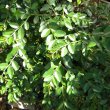
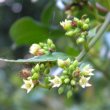
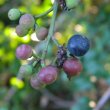
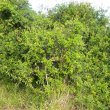
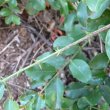
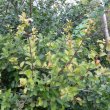
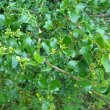


Comments
Barrier for Property
Hi
I've been researching plants that are fast growing, thorny and evergreen as a natural barrier to my property. I came across this one and it looks promising, however, I've been told it's a noxious weed. Is that true?
Thanks.
Cat thorn versus Cat's claw creeper
Hi Ipeleng
The common name for Scutia myrtina is 'Cat thorn' and is indigenous to South Africa. It is definitely not on the invasive plant's list for South Africa.
Another plant named Macfadyena unguis-cati, or 'Cat's claw creeper', is often confused with the Cat thorn. It is an invasive plant that comes from South America and it is listed as a Category one invader plant. This is the strictest category on the Declared Weeds & Alien Invader Plants list, meaning that:
'These plants may not occur on any land or inland water surface other than in a biological control reserve. Except for the purposes of establishing a biological control reserve, one may not plant, maintain, multiply or propagate such plants, import or sell or acquire propagating material of such plants except with the written exception of the executive officer.' You can find this information at http://www.plantzafrica.com/miscell/aliens1.htm.
To see what it looks like, Google 'Cat's claw creeper' and look at the images. Although it is very pretty, you will see how invasive it is.
Scutia myrtina makes a very dense, fast growing hedge and the thorns make it impossible to penetrate.
I hope this sets your mind at rest.
Kind regards
Lorraine
Thanks
Thank you for the helpful insight. Do you have any idea how fast it grows?
Speed of growth.
Hi Ipeleng
I cannot assess this as growth rate depends on water, soil fertility and the climate in which you live. As I do not have this information, all I can say is that in the hedgerows around my garden, in poor soil and dry conditions with no attention whatsoever, I have seen shoots grow from .5 to 2 meters in a season. In good conditions the plant is known to grow very fast, which means 1 - 1.5 meters a year.
Kind regards
Lorraine
Thanks
Thanks again. Your input is much appreciated :-)
Discuss this plant
Share knowledge, ask a question or give an experience.